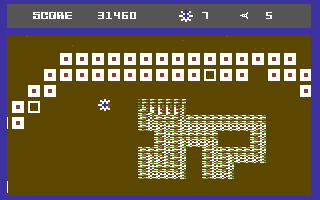Retro Replay Review
Gameplay
Survivor drops you into the void of space with little more than a small, nimble spaceship and a burning desire to stay alive. Your primary challenge is to navigate through sprawling fortresses bristling with mounted turrets, all while weaving between drifting asteroid fields. The core gameplay loop hinges on precise maneuvering, quick reflexes, and constant awareness of both incoming fire and environmental hazards.
The control scheme is surprisingly intuitive for a game of its era: thrust, rotate, and fire in any direction to keep your ship intact. As you push deeper into the level, enemy turrets become more aggressive and asteroids more densely packed, forcing you to make split-second decisions. Weapon pickups and shield boosts occasionally appear, rewarding exploration of riskier corridors or venturing off the beaten path.
Survivor’s pacing strikes a fine balance between methodical exploration and frantic action. You’ll spend moments plotting safe routes around turrets, only to find yourself suddenly bombarded by homing projectiles. This ebb and flow keeps each play session engaging, delivering a steady sense of accomplishment whenever you clear a particularly gauntleted section.
Graphics
For a title released in the early era of home computing, Survivor’s visuals hold a distinct charm. The game uses crisp, monochromatic sprites that emphasize clarity over flashy effects. This minimalist approach allows you to instantly recognize enemy turrets, asteroid clusters, and critical power-ups, even on lower-resolution displays.
The large playing area, a technical achievement for Synapse Software at the time, gives the game a widescreen feel well before widescreen was commonplace. Scrolling is smooth and keeps up with your ship’s movements, maintaining spatial awareness without stuttering or tearing. Background starfields scroll subtly to convey speed and depth without detracting from the main action.
While Survivor can’t compete with modern polygonal graphics, its stylized, retro aesthetic creates an immersive sci-fi atmosphere. The stark contrast between your ship’s bright pixels and the dark void of space heightens the sense of isolation. Color palettes are used sparingly but effectively, with occasional flashes of red and green to denote danger zones or collectible items.
Story
Survivor’s narrative is straightforward yet effective: you are lost in space, trapped in a small spaceship, and the only way to live is to fight through wave after wave of fortified structures. There’s no elaborate cutscene or lengthy dialogue—every moment you spend piloting your ship becomes part of the story. The lore is hinted at through brief text prompts, giving you just enough context to care about survival.
The lack of a sprawling, narrative-driven campaign works in the game’s favor. By focusing purely on survival, Survivor creates an immersive, sandbox-like environment where you define your own goals—whether that’s reaching a distant fortress, achieving a high score, or seeing how far you can push your skills. This open-ended design encourages repeat playthroughs and fosters a sense of personal achievement.
Though the story isn’t as fleshed out as modern space epics, Survivor’s minimalist approach lets you project your own narrative onto the experience. Are you a lone pilot stranded by a mysterious explosion, or an intrepid explorer charting unknown regions? The game’s sparse storytelling becomes a canvas for the player’s imagination, adding an unexpected layer of depth to each run.
Overall Experience
Playing Survivor today feels like stepping back into the golden age of shooter games—when every pixel counted and gameplay innovations were born from clever programming rather than elaborate assets. The tension of navigating hostile environments, combined with the joy of narrowly evading destruction, makes each session memorable. You’ll find yourself both challenged and rewarded, whether you’re a retro gaming enthusiast or a newcomer seeking a pure action experience.
Survivor’s steep difficulty curve can be unforgiving, but it never feels unfair. Each death teaches you something new: turret patterns become less intimidating, asteroid fields more predictable, and hidden pickup locations easier to spot. The game’s inherent replayability comes from mastering these nuances and pushing your skills further with every attempt.
In the context of Synapse Software’s catalog, Survivor stands out for its ambitious scope and polished execution. Fans of classic shooters like Shamus will appreciate the shared DNA, while newcomers can enjoy an unfiltered blast of retro action. The large playing area, satisfying controls, and emergent storytelling make Survivor a title worth experiencing—even decades after its original release.
 Retro Replay Retro Replay gaming reviews, news, emulation, geek stuff and more!
Retro Replay Retro Replay gaming reviews, news, emulation, geek stuff and more!








Reviews
There are no reviews yet.